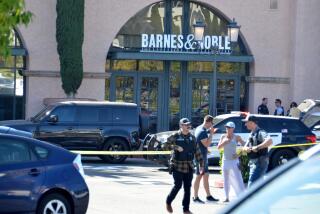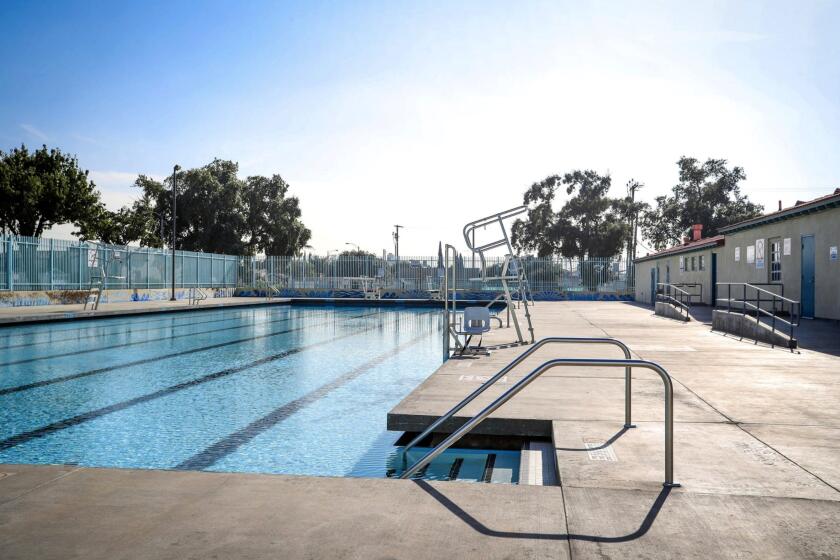COLUMN ONE : What Has Happened to the ‘LAPD 44’? : Since the Christopher Commission singled out ‘problem officers’ in 1991, some have been fired, others promoted. A few have made the list a potent symbol of agency’s woes.
Three have been fired and 10 have quit.
Nine have been promoted.
Two have killed suspects while on duty. And one stands accused of falsifying evidence in a murder case.
For most of the 44 Los Angeles Police Department officers labeled “problem officers” in the landmark 1991 Christopher Commission report, the past four years have been tumultuous.
The commission said its intention was to illustrate, not define, what it called “the problem of excessive force in the LAPD.” It singled out those with six or more complaints of excessive force or improper tactics lodged against them from 1986 through 1990--whether sustained or not.
But the results have been mixed. While the LAPD has weeded out some on the list, a handful continue to generate controversy. And the list remains a potent symbol of all that is wrong with the embattled LAPD--as was proven yet again in recent weeks when Officer Michael Falvo shot and killed a Lincoln Heights teen-ager.
Two nights of unrest followed the July 29 shooting. Then came the disclosure that Falvo had been assigned to volatile anti-gang patrol despite being on the list and having a lengthy history of alleged brutality.
“The Christopher Commission saw this kind of ‘problem officer’ as a symptom of a department whose values are inappropriate,” said Rabbi Gary Greenebaum, former president of the Police Commission, the LAPD’s civilian watchdog agency. “That these sorts of officers are not only tolerated but in many cases were promoted suggests that you’ve got a department that’s out of sync with the rest of the community.”
The more than 100 reforms urged by the Christopher Commission, meanwhile, have been slow in taking root, according to interviews with top LAPD officials and community activists.
The Police Commission has launched anew a thorough study of LAPD operations, including why commanders--up to and including top brass--are not held accountable for the use of force by subordinates, as the Christopher Commission recommended. Meaningful change is likely still to be at least a year away, said Deirdre Hill, the current Police Commission president.
But for those on the list, change came almost immediately.
The officers were frequently confronted with heightened scrutiny, transfers and make-work assignments--all of which commanders made clear was the price those on the list had to pay. As a result, many have spent the past four years brooding over their inclusion on the list, bemoaning lost career opportunities and angry at top department and police union officials for doing little or nothing to restore tarnished reputations.
Former Officer Taroo A. Mason, who was fired in 1990, said the general regard for those officers still with the LAPD is unforgiving: “They’re lepers.”
And so four years later, the list of 44 still presents a fundamental dilemma for the LAPD: What to do with those who remain?
Seeking to update the assignments and disciplinary histories of the 31 “problem officers” still on the force, The Times obtained a database prepared by the Police Commission. It tracks the records of each officer from 1991 through 1994.
The database followed 34 officers--three left this year. The database, along with interviews and a review of lawsuits, job evaluations and the transcripts of disciplinary and pension board hearings, reveals:
* Seven officers were involved in shootings. All but one of the incidents were ruled “in policy,” meaning LAPD reviewers believed the officer had a right to fire. In the sole exception, Joe L. Moore was shot at while off duty in 1993 and returned fire with a warning shot. Moore said in an interview that he was formally reprimanded. The incident involving Falvo--too recent to be included in the database--is expected to be ruled “in policy,” police sources said.
* Twenty-seven officers were the targets of 78 complaints. Four complaints were for use of excessive force, and 12 were for use of unauthorized force; none of these were sustained.
Five complaints, two of which were sustained, were for using unauthorized tactics. In a 1988 incident that did not come to light until 1991, Andrew A. Teague was captured on video pushing a suspect off a porch. That earned him an official reprimand. Thomas J. Hickey drew a one-day suspension for using his own rope to lock a handcuffed robbery suspect in the back of a police car during the 1992 riots.
The other 57 complaints included accusations that ranged from theft (lodged against one officer and ruled unfounded) to bad driving (traffic accidents involving six officers, all formally admonished).
* Those promoted generally rose one level, some to detective. “Probably their promotional chances, even though several have been promoted, have been hindered” by being on the list, said Cmdr. Tim McBride, the LAPD’s spokesman. Teague, who made detective within the last year, was suspended Sept. 1 after confessing to district attorney’s investigators that he had forged signatures on reports identifying suspects in a murder case and lied about it in court, Chief Willie L. Williams said at a press conference.
* Of the 31 officers still with the LAPD, 10 are assigned to regular patrol duties. Some were yanked out of the field after the shooting involving Falvo, including Henry J. Cousine, who said he was told by a supervisor that he ought to work a desk until “things cool off.” Now, Cousine greets visitors in the front lobby at Parker Center, the police headquarters Downtown. “I’m a soldier,” he said. “And I’m doing a secretary’s job.”
McBride said the database findings reflect the sort of mixed bag one would expect when comparing the careers of nearly three dozen officers--some “doing quite well” while others “may not be doing quite as well.”
The one constant, McBride said, is the notoriety of being one of the 44: “The half-life of being on the Christopher Commission list seems to go on forever for these officers.”
Headed by Warren Christopher, a Los Angeles attorney who has since become U.S. secretary of state, the commission based the list of 44 on an LAPD computer program that set forth the total number of complaints against each officer; officers were identified solely by badge number. Other factors were not considered.
Those on the list, however, complain that it is based on flawed methodology--that the Christopher Commission report did not fully explain why six or more complaints were a suitable benchmark or why the panel, made up mostly of lawyers, felt it appropriate to count allegations of wrongdoing rather than proven misconduct.
“It is an arbitrary listing or arbitrary cutoff,” said attorney John W. Spiegel, general counsel of the Christopher Commission. “You could have had 183 officers with four or more complaints,” figures the 1991 report also documented.
The fact that the Falvo shooting and Teague’s suspension “attracted so much attention, and rightly so,” proves that the Christopher Commission succeeded in “identifying a problem,” Spiegel said.
Countered Cliff Ruff, president of the Los Angeles Police Protective League, the officers’ union: “If this list of 44 is such a problem, where did the Christopher Commission fail in not putting Mark Fuhrman on the list?”
Fuhrman, the ex-detective whose racist remarks reverberated throughout the nation when they were revealed at the O.J. Simpson murder trial, retired a few weeks ago. His case, Ruff said, underscores the Christopher Commission’s flaw in focusing on numbers alone: “Their theory, which is skewed, is that where there’s smoke, there’s fire.”
Those burned most severely, Ruff said, were the officers who did not deserve to make the list because none of the force or tactics complaints lodged against them from 1986 through 1990 were found to have merit. Chief among them, according to LAPD sources, are Craig D. Lally and Joseph M. [Mike] Doherty. In addition, neither picked up a complaint of any kind from 1992 to 1994.
“I would be really happy if someone would just do a retraction, say, ‘He doesn’t belong on the list anymore,’ ” Doherty said.
Apologies are not forthcoming, top LAPD commanders said.
Instead, what the 31 remaining officers can likely expect are recurring bouts of what the Christopher Commission called “management attention”--recurring, as it has for four years, whenever public attention is focused on the LAPD.
For instance, immediately after the list was compiled, each officer was given a “tailored plan,” consisting of training, counseling or both, said Nels Klyver, chief of the department’s in-house counseling staff. He declined to say how many of the 44 saw a counselor, saying only that it was a “small number.”
Several officers on the list said the training and counseling were of little value. “A bunch of b.s.,” said one. “I went and saw a department psychologist for an hour and a half, and I took a test. That was it.”
From 1991 through 1993, meanwhile, each officer was reviewed frequently, and a point was made of routing those evaluations to LAPD command staff, Assistant Chief Ronald Banks said.
Sometime in 1993, Banks said, that “centralized review process” came to a halt, essentially because public focus on the list had waned.
In mid-August, however, a few weeks after the Falvo shooting and just days before the Fuhrman tapes were aired, Parker Center once again ordered evaluations of those still on the force.
According to the paperwork that accompanied the order, field commanders were asked: “Should the officer remain in the current assignment or [be] reassigned?”
It is not the sort of thing that does wonders for morale, several officers on the list said.
“Here I’ve gone my whole life being a good person, doing the best I can, and I’m getting crucified for a government job,” Officer Andrew Wunderlich said. “I’ve always considered myself a political pawn.”
Officer Donald J. Jenks said: “We are in a political situation. It’s just going to get more political. When it’s all over with, the LAPD is going to be wounded. But life will go on.”
As the following portraits illustrate, however, those on the list have faced a variety of consequences.
CONRAD COTA JR.
Other officers call Cota a good cop, saying he was a dependable veteran while on patrol in tough Eastside neighborhoods. But he compiled perhaps the most problematic record among any of the officers--even after publication of the list.
In 1989, according to court documents, Cota pushed Benjamin Rojas into a fence in El Sereno, punched him in the face, wrestled him to the ground and hogtied him during a traffic stop. Rojas sued, alleging excessive force, and won. The city paid out $64,578.
In 1990, Cota chased Jorge Vargas, a suspect in an Eastside burglary. Vargas died. His parents sued, claiming that Cota killed Vargas by beating him on the head with a flashlight. Cota denied wrongdoing, saying Vargas died after striking his head on a curb upon being tackled. A jury ruled against Cota. The city paid out $339,047.
In 1994, six months after the Vargas verdict was returned, Cota confronted Michael Fiero Arocha on an El Sereno street corner. Tucked into Arocha’s rear waistband was a pistol, which looked real but turned out to be a plastic toy, police said. Cota shot Arocha three times, killing him.
After two prior jury verdicts against him, why was Cota still out on patrol? The question may not be answered until a trial set for Dec. 4 in Los Angeles Superior Court. Survivors contend that Cota violated Arocha’s civil rights.
“This guy should never have been on the street,” said Alan S. Gutman, a Beverly Hills attorney who represented Vargas’ parents and represents Arocha’s family.
Randy Brittsan, 38, a Vons grocery warehouse worker and foreman of the jury in the Vargas case, said: “This officer, I think he was taking this job as if he had to clean up the streets all by himself.”
Deputy City Atty. Ellen Fawls declined to respond, saying she could offer no comment because the trial is pending.
But according to documents reviewed by The Times, the LAPD has ruled that the shooting was justified.
Chief Williams found that Cota fired in fear for his own life after seeing Arocha’s “right shoulder and upper arm move forward as if Arocha had drawn his weapon and was about to shoot.” Williams emphasized that he was “pleased with the . . . sharp observations and awareness” of Cota and his partner--even though Arocha’s gun turned out to be a fake.
A few weeks after the LAPD ruled the shooting “in policy,” Cota resigned and moved north, where he was hired as a deputy with the Sacramento County Sheriff’s Department.
Now working as a jail guard, Cota, 35, did not return calls seeking comment. Sgt. John McGinness, the Sacramento department’s spokesman, said: “Despite the Christopher Commission findings, I believe we’re dealing with a competent officer here.”
He added: “We spoke with neighbors and let me share with you what we got in terms of comments: ‘reliable, good person, good neighbor’; ‘good family man’; ‘level-headed’; ‘highly dedicated, good judgment’; ‘some of the nicest neighbors I have ever had.’
“We couldn’t find anybody who had a negative comment.”
THOMAS J. HICKEY
Hickey’s reason for being was to carry a badge. He had been a one-man crime-stopper in the San Fernando Valley. After making the list, he seemed to fall apart professionally and personally.
From 1986 through 1990, he made 2,101 arrests and worked a staggering amount of overtime, more than 2,000 hours. Based at the Van Nuys station, he also was involved in 41 incidents involving force from 1986 through 1991. He picked up eight complaints for excessive force from 1986 through 1990, one of which led to a jury trial. All eight were unsustained.
Nonetheless, after showing up on the list, Hickey was frequently told to ride a desk and sometimes given make-work assignments; one day he was ordered to inspect the urinals at the station.
“My whole life was wrapped up in what people thought of me as a police officer,” said Hickey, 34. “When the Christopher Commission took that away from me, there was nothing left.”
Hickey said he hit the bottle--hard. And he said he cheated on his wife, Sherry, who eventually filed for divorce.
When he was allowed out on patrol, he ran into more trouble.
In August, 1991, he was driving a black-and-white that, according to records, sent a computer message to another squad car reading: “A beef a day keeps the sergeants at bay.” For that, he earned an official reprimand.
On May 3, 1992, while on duty during the riots, he and a partner arrested two robbery suspects in Sherman Oaks. Hickey cuffed one suspect’s hands behind his back, then sat him in the back of the patrol car, ran an orange-and-black nylon rope through the cuffs, closed the door to the car and tied a fat knot in the rope outside the door.
That tactic violated LAPD policy because Hickey used his own rope, not a department-approved device. Hickey was suspended for one day.
Off duty he found trouble, too. In June, 1993, at a Van Nuys apartment complex, Hickey confronted another LAPD officer, a woman who had become friends with his estranged wife. Words were exchanged, and Hickey said he told the officer that if she didn’t do a better job of backing up other officers on patrol, “I’ll kill you.” That earned him a three-day suspension.
In July, 1993, a Superior Court jury cleared Hickey of charges that he had used excessive force during a 1987 arrest.
When the trial ended, Hickey checked himself into a Van Nuys psychiatric hospital for two weeks. Since then, he said, he hasn’t touched a drink. He reunited with his wife and children. He went back to police work. He was even promoted to detective and was named Wilshire Division “detective of the quarter” this year.
A few weeks ago, however, after the shooting involving Falvo, a lieutenant told Hickey that she had orders to update his personnel file. He finished the day, then announced he was quitting--tired of the stigma of being on the list.
On Sept. 27, their things loaded in a 26-foot Ryder van, Hickey and his family set off for the “rural East Coast.” Neither he nor his wife have a job lined up. “We’ll be on welfare,” he said with a laugh. “Eat government cheese.”
HENRY J. COUSINE
Being on the list, Cousine once said, makes one “totally infamous.” That’s the reason he knows what it can feel like to be treated as a suspect by the LAPD.
Heading home the night of March 23, 1994, Cousine was stopped by Officers Diane Ponce and Arturo Koenig, who directed him off the Santa Monica Freeway and onto Arlington Avenue for allegedly cruising through a red light at the freeway on-ramp at Crenshaw Boulevard. He was recognized immediately.
According to LAPD documents obtained by The Times, Koenig said Cousine used the word “f---” about 15 to 25 times in protesting the stop. Ponce said Cousine’s comments were laced with the same obscenity.
Cousine was hauled off to the Southwest station, where he was held for two hours and given sobriety tests--which showed he had not been drinking--and told to go home. Then, based on the comments from Koenig and Ponce, the department slapped Cousine with a complaint--his 24th in nearly 12 years--alleging that he made an “improper remark.”
Cousine denied running the red light, according to the LAPD documents. He also denied making the statements that Ponce attributed to him.
Of Cousine’s 23 prior complaints, 10 had been sustained. Five of the 23 had been for off-duty behavior, and one of those five--a fight in 1991--had earned him a 44-day suspension and a formal warning from a captain at a Board of Rights hearing: “This board sincerely wonders, Officer Cousine, when you are going to wake up.”
Cousine, now 35, said he got the message. “I’ve been clean as a Safeway chicken,” he said, admonished once in recent months for working off duty without a permit and suspended one day for forgetting a target practice session, but otherwise clean.
It turned out, according to the LAPD documents, that a man who lived across the street had seen the entire freeway ramp incident and backed Cousine, saying he never heard Cousine use profanity.
After being cleared by Internal Affairs, Cousine sued Ponce, Koenig and various supervisors as well as Chief Williams and the city of Los Angeles, alleging a violation of his civil rights as well as assault and battery. Trial is set in Los Angeles Superior Court for Nov. 29.
Calls to Ponce and Koenig were referred to Deputy City Atty. Kjehl T. Johansen, who declined to comment.
Asked how it feels to have been treated as a suspect, Cousine replied: “It feels humiliating and demeaning.”
TAROO A. MASON
Being on the list--even eventually getting fired--didn’t stop Mason from getting a stress disability pension that guarantees him at least $1,969 per month for the rest of his life.
In July, 1990, a year before the list was published, Mason was fired from the LAPD for misconduct.
Four years later, claiming that his 18-plus years on the beat had left him stressed out and caused a variety of other ailments, he was awarded the pension.
Mason, 49, has a new job--as a deputy marshal at the U.S. Courthouse in Downtown Los Angeles. For those who would ask whether he is deserving of the pension, he has a ready response:
“I would ask them where they are on the nights I wake up with recurring nightmares about police officers I know who have been killed, the nights I wake up reliving shootings I have been in and the days dealing with the physical pain I deal with every day.”
Mason arrived on the force in 1972, a combat-decorated Vietnam War veteran. Over the next 18 years, he won a slew of awards, including the Medal of Valor, the department’s highest award for bravery, for rescuing a woman and child from a burning Hollywood apartment in 1982.
He and Stacey C. Koon, who was convicted in federal court on charges stemming from the Rodney G. King beating, were once partners. Koon, Mason said, was “one of the best officers I ever worked with.”
From 1982 to 1990, Mason was suspended without pay for a total of 75 days. In 1990, he was fired after a disciplinary board found him guilty of several charges, including the unprovoked beating of a 40-year-old man.
Mason said of his years as an officer: “I think I was psychologically more injured by the LAPD than I was in Vietnam. At least there [in Vietnam], I knew who the enemy was.”
CRAIG D. LALLY
Once, Lally’s career brimmed with promise and excitement. Now, he has gone to court, proclaiming that none of the complaints that got him on the list were sustained, and bitter that his own union did nothing to restore his reputation.
For most of his career, the 39-year-old Lally just seemed to have the knack. He was assigned to the elite Metropolitan Division and was promoted to sergeant.
When, in a haunting 911 call, Nicole Brown Simpson begged a dispatcher to send police to her townhouse on Gretna Green Way in October, 1993, it was Lally who responded.
When comedian John Belushi was found dead in 1982 of an overdose at the Chateau Marmont hotel on the Sunset Strip, Lally was one of the officers at the scene.
When the list of 44 came out, Lally was perplexed.
So he turned to the Police Protective League. He now contends that union lawyers created an attorney-client relationship and then breached it by failing to pursue legal action against the city, the LAPD or the Christopher Commission on behalf of those officers on the list. The union never filed any such lawsuit, general counsel Hank Hernandez said.
Lally’s lawsuit, filed in Van Nuys Superior Court in March, 1994, seeks general damages of $3 million and punitive damages of $5 million. On Sept. 27, a judge whittled the case down but a rehearing is set for Nov. 6 and a trial for April 9.
Hernandez said Lally’s lawsuit is “without merit,” adding, “We have no affirmative duty of suing anybody on a police officer’s behalf.”
Currently assigned to the West Los Angeles station, Lally was eagerly looking forward to a transfer to the prestigious Internal Affairs bureau, particularly after a two-month stint there a few months back. But no transfer has been forthcoming--and, Lally sighed, probably never will be.
“What do you think would [be the reaction] if I was IA and investigating officers for excessive force and I’m on the list of 44? Gimme a break,” Lally said.
He added that he has been turned down for promotion more than a dozen times since 1991.
“I’m not politically correct,” he said.
(BEGIN TEXT OF INFOBOX / INFOGRAPHIC)
(BullDog Edition, A25) Status Report
The Christopher Commission, in its examination of excessive force in the Los Angeles Police Department, compiled a list of 44 “problem officers” with six or more complaints of excessive force or improper tactics between 1986 and 1990. Neither the commission nor the LAPD has ever released the list, but The Times has obtained it. Here are the officers’ names and their status or station assignment as of summer, 1995.
Name: Station
Abiel Barron: Detective Headquarters
Fernando O. Cardona: Hollenbeck
Stephen M. Carmona: Hollywood
Henry J. Cousine: Central
Joseph M. (Mike) Doherty: Air Support
John P. Edwards: Van Nuys
Michael A. Falvo: Hollenbeck
Jerry D. Fritz: North Hollywood
Jerry J. Greenfield: Southeast
Rigoberto Gutierrez**: Devonshire
James C. Hagerty: Metro
William B. Harkness: Personnel
Donald J. Jenks: Harbor
Steve V. Kolb: Burglary / Auto Theft
Craig D. Lally: West L.A.
Maurice L. Landrum: South Bureau Homicide
Richard C. Madison: Central Traffic
Sean B. McGee: Air Support
William Merchant: West L.A.
Joe L. Moore: Central
John A. Pasierbowicz: Traffic Coordination
Jimmy V. Provencio: Hollywood
Scott H. Shepherd: Commission Investigations
Andrew A. Teague*: Van Nuys
Pedro J. Ugarte: Van Nuys
Rudy V. Vidal: Newton
Benjamin Warren: Harbor
John D. Williams: West Bureau Narcotics
Richard M. Womack: Narcotics
Andrew Wunderlich: Officer Representation
Leslie C. Wyeth: Hollywood
****
NO LONGER WITH DEPARTMENT
Raymond A. Bennette: disability pension 6/17/93
Conrad Cota: resigned 7/2/95
Stephen C. Geon: service pension 4/2/94
Joel Herbst: resigned 8/15/89
Thomas J. Hickey: resigned 9/25/95
Taroo A. Mason: fired 7/12/90
John Mitchell: resigned 5/16/88
Leonard Mora: fired 1/29/90
Donald W. Murphy: service pension 3/26/95
Nick Savala: fired 12/19/88
Carl A. Sims: resigned 6/1/92
Juan M. Torres: disability pension 7/15/93
Michael S. Tosti: resigned 12/1/91
* Teague was suspended Sept. 1 by Chief Willie L. Williams, accused of falsifying evidence in a murder case.
** Gutierrez has applied for a disability pension. His claimed disability: “Psyche.” A hearing is scheduled for Dec. 21.
More to Read
Start your day right
Sign up for Essential California for news, features and recommendations from the L.A. Times and beyond in your inbox six days a week.
You may occasionally receive promotional content from the Los Angeles Times.






